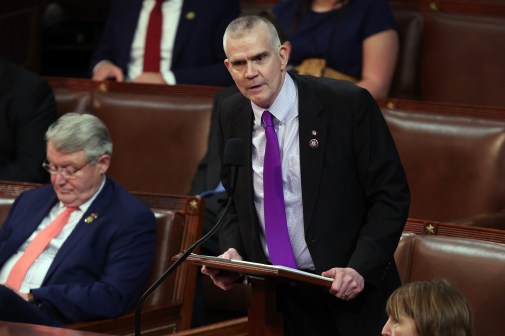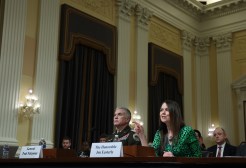Veterans’ CIO sets vision for IT excellence

(iStockphoto)
The chief information officer of the Department of Veterans Affairs laid out her reinvented but “logical” vision for the future of her agency’s IT operations Thursday, saying she wanted to improve vets’ experience by recommitting to IT best practices and looking ahead to emerging technologies like the Internet of Things.
LaVerne Council unveiled her framework, beginning with the needs of veterans and the pressures felt internally and externally within her Office of Information and Technology, and expanding into a concrete plan on how her organization can transform and execute on her new vision — “to be world class, have a seamless, unified veteran experience and deliver state-of-the-art technology,” she said.
“It’s all about delivering the best in the seamless, most frictionless way we possibly can to our veterans through state-of-the-art technology. Everything should go to making that happen,” said Council, whose keynote at Thursday’s Government Information Technology Executive Council meeting was her first public speech since being confirmed in July.
“The external forces and internal complexity demand change. It is not an option,” she said. “When you have that many things changing on the outside, that many things changing and needing change on the inside, we have to transform.”
In one of her first interviews with media, Council last week outlined to FedScoop the focuses of her first 100 days — developing an Enterprise Cybersecurity Strategy and other foundational elements, many of which her office had been lacking. She gave more details Thursday on that foundation around which she is building her vision for OI&T.
“Transformation requires a strong technical foundation in IT. Because if not, we sort of start to get excited, and then it dies off. You don’t have a guidepost,” Council said. “In our case we’re really looking at tying ourselves strongly to an enterprise architecture that looks at mission alignment, data visibility and interoperability, infrastructure interoperability, our security processes, and having better enterprise services.”
While her address incorporated several guiding principles commonplace in many successful organizational strategies found around government — accountability, teamwork, leadership and transparency, for example — Council put an emphasis on innovation, something rarely paired with the any of VA’s operations.
“Innovation is really, I think, the backbone of IT,” she said. “There is innovation in how you think and work with people. There is innovation in not only software you create but also how people engage it … We have to be innovative; it is a requirement. We have to think from the eyes of those who are using our products, not from the eyes of those that are creating them.”
An important focus of her strategy, she explained, was planning for and harnessing new technologies, particularly the buzzy Internet of Things. After targeting cybersecurity as one of her immediate concerns on entering the CIO office, Council has began directing her team’s attention to areas like IoT to acknowledge and anticipate their impacts, especially in the medical world.

LaVerne Council speaks at a Government Information Technology Executive Council event Oct. 15. (FedScoop)
“We’ve set forward a domain and a key part of our security to understand it,” she told FedScoop after her keynote. Now, VA’s OI&T is beginning to explore what IoT will mean for the office, potentially writing some white papers “that we will develop in hopes of tying up a couple of relationships,” like “internal cloud calibrations” with business partners as well as external partners developing new products, she said.
“It’s an area that’s going to be high in collaboration, needs strong focus to understand it … and one in which we need to be sure we’re walking lockstep with where external industry is going,” Council told FedScoop.
And the IoT wave is one that presents itself internally and externally for the VA, especially as veterans become more mobile.
“Our objective should be to ensure that we can get that kind of veteran experience tied into the fact that most veterans are using mobile devices, and mobility has become a key part of how the general public sees themselves interfacing with technology,” she said. “Also, it might be the mobility of the [doctor] or the mobility of the claims person, because they could take the solution with them and make a decision at point of disposition versus at their desk.”
For all the positivity and optimism for the future in her talk, the new VA CIO was not afraid to address the sort of elephant in the room — the tarnished reputation that her office, and the VA in general, has developed in recent years as the focal point in last year’s waitlist scandal related to the deaths of numerous veterans, the electronic health record interoperability issues between her agency and the Defense Department, and a legacy of information security issues.
Part of that, she said, is eliminating material weaknesses, which organizations just tend to avoid because of the negativity, she said. “But the fact is, that’s what we’ve got to do. If that’s how the [inspector general] looks at it. Let’s just call it out, get it done, put it to sleep and move on. It’s a good thing.”
She also has to account for the departure of several key OI&T leaders, such as Stephen Warren, former principal deputy assistant secretary and former acting chief information officer, in her new transformational strategy, which relies heavily on people, leadership and accountability.
“Certainly someone’s decision to change career paths is theirs,” Council told FedScoop in a statement. “We have great talent, and there’s great talent outside — and every change creates an opportunity. We’d certainly appreciate new talent joining our team to help us implement our framework.”
This strategy differs from those in the past, though, she said, because “we didn’t have a core anchor for the team to tie to … it is different than anything the organization has done before, and I think people are looking for that guidepost as something they can be buoyed to and feel something that’s going to be successful.”
And despite her political appointment, which will inevitably limit her time as VA CIO, Council said she’s dedicated to effecting lasting change within her office because she believes in VA’s mission.
“Why transform now? Why not just kick the rock?” she asked rhetorically. “Because that rock might be a diamond.”





